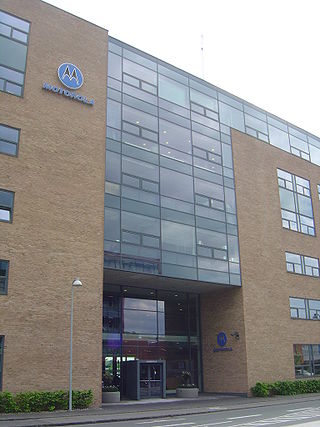
Motorola, Inc. was an American multinational telecommunications company based in Schaumburg, Illinois. It was founded in 1928 as Galvin Manufacturing Corporation by brothers Paul and Joseph Galvin. The company changed its name to Motorola in 1947. After having lost $4.3 billion from 2007 to 2009, Motorola was split into two independent public companies, Motorola Mobility and Motorola Solutions, on January 4, 2011. The reorganization was structured with Motorola Solutions legally succeeding Motorola, Inc., and Motorola Mobility being spun off.

3Com Corporation was an American digital electronics manufacturer best known for its computer network products. The company was co-founded in 1979 by Robert Metcalfe, Howard Charney and others. Bill Krause joined as President in 1981. Metcalfe explained the name 3Com was a contraction of "Computer Communication Compatibility", with its focus on Ethernet technology that he had co-invented, which enabled the networking of computers.

The Motorola Razr is a brand of design-oriented mobile phones manufactured by Motorola Mobility, a division of Lenovo. Its current iteration since 2019, styled motorola razr, consist of foldable smartphones reminiscent of the original Razr line of flip phones.
Federal-Mogul Corporation is an American developer, manufacturer, and supplier of products for automotive, commercial, aerospace, marine, rail, and off-road vehicles, as well as industrial, agricultural, and power-generation applications. It was acquired in February 2022 by Apollo Global Management.

The Motorola RAZR V3, popularly called simply the Razr, is a clamshell style cell phone developed by Motorola and initially released in November 2004, the first device using the RAZR moniker. With its unique and then-thin aluminium body, coupled with a high price, the RAZR V3 was initially positioned as a desirable premium phone; following price reductions, it then became extremely successful. In the United States the V3 was the most popular cell phone in 2005, 2006 and 2007 and remained best-selling until November 2008.

Jonathan J. "Jon" Rubinstein is an American electrical engineer who played an instrumental role in the development of the iMac and iPod, the portable music and video device first sold by Apple Computer Inc. in 2001. He left his position as senior vice president of Apple's iPod division on April 14, 2006.

Motorola Mobility LLC, marketed as Motorola, is an American consumer electronics manufacturer primarily producing smartphones and other mobile devices running Android. Headquartered at Merchandise Mart in Chicago, Illinois, it is a subsidiary of the Chinese multinational technology company Lenovo.

Mike Svetozar Zafirovski is a Macedonian American business executive.
Christopher B. Galvin is an American businessman. He served as the chairman and chief executive officer of Motorola from 1997 to 2003.

Martin Cooper is an American engineer. He is a pioneer in the wireless communications industry, especially in radio spectrum management, with eleven patents in the field.
SCREEN3 is a technology used and designed by Motorola to push news and information to mobile phones.

Open Interface North America (OINA) was a privately owned embedded Bluetooth software provider based in Seattle, Washington and was incorporated in 2000 as a division of the Japanese company Open Interface, Inc., which had formed in 1992. Akemi Sagawa, a Microsoft product manager at the time, was hired to run it. Another former Microsoft employee, Greg Burns, was brought in as chief technology officer.
Gregory Q. Brown is an American businessman. He has been chairman and chief executive officer of Motorola Solutions since 2008.
The Motorola Razr2 (often stylized as RAZR2) is a series of clamshell/flip mobile phones from Motorola, and is one of the series in the 4LTR line. It is the successor to the popular Razr series. The Razr2 is 2 mm thinner than its predecessor but slightly wider. Some versions feature Motorola's MotoMagx operational platform, based on the MontaVista Linux OS. The Razr2 was made available on every US carrier, and EVDO, GSM and HSDPA versions of it were released by late 2007.
Airclic is a web-based software and mobile information services company founded in 2000. Airclic offers fully hosted solutions including a workflow-based mobile application framework.
Samsung Mobile Division is one of the five divisions within Samsung Electronics, belonging to the Samsung Group, and consists of the Mobile Communications Division, Telecommunication Systems Division, Computer Division, MP3 Business Team, Mobile Solution Centre, and Telecommunication R&D Centre. Telecommunication Business produces a full spectrum of products from mobiles and other mobile devices such as MP3 players and laptop computers to telecommunication network infrastructure. The headquarters is located in Suwon, South Korea.
Daniel R. Hesse is the former chief executive officer of Sprint Corporation.

Francis Aurelio deSouza is an American entrepreneur and business executive. He is the former president and chief executive officer (CEO) of Illumina and a member of the Board of Directors of The Walt Disney Company.

Iqbal Arshad is an American engineer, inventor, speaker and technology executive. He has served as the senior vice president of engineering and global product development at Motorola Mobility, Google and Lenovo, and has been responsible for design and development of industry-leading smartphones, tablets smartwatches, wearables, silicon, and mobile computing technologies.
Jeff Jacobson is an American business executive. Currently the executive chairman of Electronics For Imaging (EFI), he is also an executive partner at SIRIS Capital Group LLC. He previously served as the CEO of EFI, Xerox Corporation, Presstek, Kodak Polychrome Graphics, and as COO of Kodak's Graphic Communications Group.











